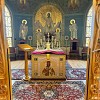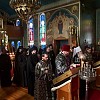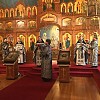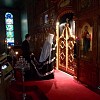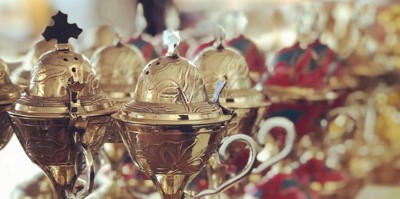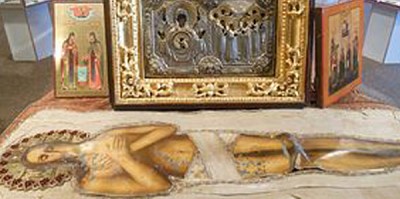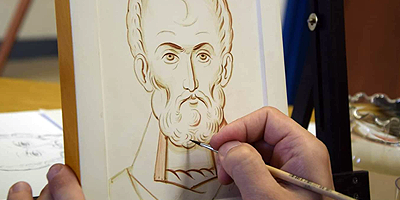Part one of four by Fr Alexander Schmemann+
The late Fr Alexander Schmemann created an outline of Lent to help the faithful better understand and appreciate this Season in Church Life. It will be presented in four parts as Lent progresses.
The Liturgical Structure of Lent
To understand the various liturgical particularities of the Lenten period, we must remember that they express and convey to us the spiritual meaning of Lent and are related to the central idea of Lent, to its function in the liturgical life of the Church. It is the idea of repentance. In the teaching of the Orthodox Church however, repentance means much more than a mere enumeration of sins and transgressions to the priest. Confession and absolution are but the result, the fruit, the "climax" of true repentance. And, before this result can be reached, become truly valid and meaningful, one must make a spiritual effort, go through a long period of preparation and purification. Repentance, in the Orthodox acceptance of this word, means a deep, radical reevaluation of our whole life, of all our ideas, judgments, worries, mutual relations, etc. It applies not only to some "bad actions," but to the whole of life, and is a Christian judgment passed on it, on its basic presuppositions. At every moment of our life, but especially during Lent, the Church invites us to concentrate our attention on the ultimate values and goals, to measure ourselves by the criteria of Christian teaching, to contemplate our existence in its relation to God. This is repentance and it consists therefore, before everything else, in the acquisition of the Spirit of repentance, i.e., of a special state of mind, a special disposition of our conscience and spiritual vision.
The Lenten worship is thus a school of repentance. It teaches us what is repentance and how to acquire the spirit of repentance. It prepares us for and leads us to the spiritual regeneration, without which "absolution" remains meaningless. It is, in short, both teaching about repentance and the way of repentance. And, since there can be no real Christian life without repentance, without this constant "reevaluation" of life, the Lenten worship is an essential part of the liturgical tradition of the Church. The neglect of it, its reduction to a few purely formal obligations and customs, the deformation of its basic rules constitute one of the major deficiencies of our Church life today. The aim of this article is to outline at least the most important structures of Lenten worship, and thus to help Orthodox Christians to recover a more Orthodox idea of Lent.
(1) Sundays of Preparation
Three weeks before Lent proper begins we enter into a period of preparation. It is a constant feature of our tradition of worship that every major liturgical event – Christmas, Easter, Lent, etc., is announced and prepared long in advance. Knowing our lack of concentration, the "worldliness" of our life, the Church calls our attention to the seriousness of the approaching event, invites us to meditate on its various "dimensions"; thus, before we can practice Lent, we are given its basic theology.
Pre-lenten preparation includes four consecutive Sundays preceding Lent.
1. Sunday of the Publican and Pharisee
On the eve of this day, i.e., at the Saturday Vigil Service, the liturgical book of the Lenten season – the Triodion makes its first appearance and texts from it are added to the usual liturgical material of the Resurrection service. They develop the first major theme of the season: that of humility; the Gospel lesson of the day (Lk. 18, 10-14) teaches that humility is the condition of repentance. No one can acquire the spirit of repentance without rejecting the attitude of the Pharisee. Here is a man who is always pleased with himself and thinks that he complies with all the requirements of religion. Yet, he has reduced religion to purely formal rules and measures it by the amount of his financial contribution to the temple. Religion for him is a source of pride and self-satisfaction. The Publican is humble and humility justifies him before God.
(2) Sunday of the Prodigal Son
The Gospel reading of this day (Lk. 15, 11-32) gives the second theme of Lent: that of a return to God. It is not enough to acknowledge sins and to confess them. Repentance remains fruitless without the desire and the decision to change life, to go back to God. The true repentance has as its source the spiritual beauty and purity which man has lost. "…I shall return to the compassionate Father crying with tears, receive me as one of Thy servants." At Matins of this day to the usual psalms of the Polyeleos "Praise ye the name of the Lord" (Ps. 135), the Psalm 137 is added, "By the rivers of Babylon, there we sat down, yea we wept, when we remembered Zion... If I forget thee, O Jerusalem, let my right hand forget her cunning..." The Christian remembers and knows that what he lost: the communion with God, the peace and joy of His Kingdom. He was baptized, introduced into the Body of Christ. Repentance, therefore, is the renewal of baptism, a movement of love, which brings him back to God.
(3) Sunday of the Last Judgment
(Meat Fare)
On Saturday, preceding this Sunday (Meat Fare Saturday) the Typikon prescribes the universal commemoration of all the departed members of the Church. In the Church we all depend on each other, belong to each other, are united by the love of Christ. (Therefore no service in the Church can be "private".) Our repentance would not be complete without this act of love towards all those, who have preceded us in death, for what is repentance if not also the recovery of the spirit of love, which is the spirit of the Church. Liturgically this commemoration includes Friday Vespers, Matins and Divine Liturgy on Saturday.
The Sunday Gospel (Mt. 25, 31-46) reminds us of the third theme of repentance: preparation for the last judgment. A Christian lives under Christ’s judgment. He will judge us on how seriously we took His presence in the world, His identification with every man, His gift of love. "I was in prison, I was naked..." All our actions, attitudes, judgments and especially relations with other people must be referred to Christ, and to call ourselves "Christians" means that we accept life as service and ministry. The parable of the Last Judgment gives us "terms of reference" for our self-evaluation.
On the week following this Sunday a limited fasting is prescribed. We must prepare and train ourselves for the great effort of Lent. Wednesday and Friday are non-liturgical days with Lenten services (cf. infra). On Saturday of this week (Cheesefare Saturday) the Church commemorates all men and women who were "illumined through fasting" i.e., the Holy Ascetics or Fasters. They are the patterns we must follow, our guides in the difficult "art" of fasting and repentance.
|
| |||||||||||||
175 St. Tikhon's Road
Waymart, PA 18472
Thu
2MayHoly Thursday
8:00 Hour and Liturgy of St. Basil
6:00 12 Passion GospelsFri
3MayHoly Friday
8:00 Royal Hours
3:00 Vespers with placing of Plashnitsa
7:00 Matins for Holy SaturdaySat
4MayHoly Saturday
7:40 Hours and St. Basils Liturgy
11:30 Midnight Office
12:00 Matins and Paschal Liturgy


